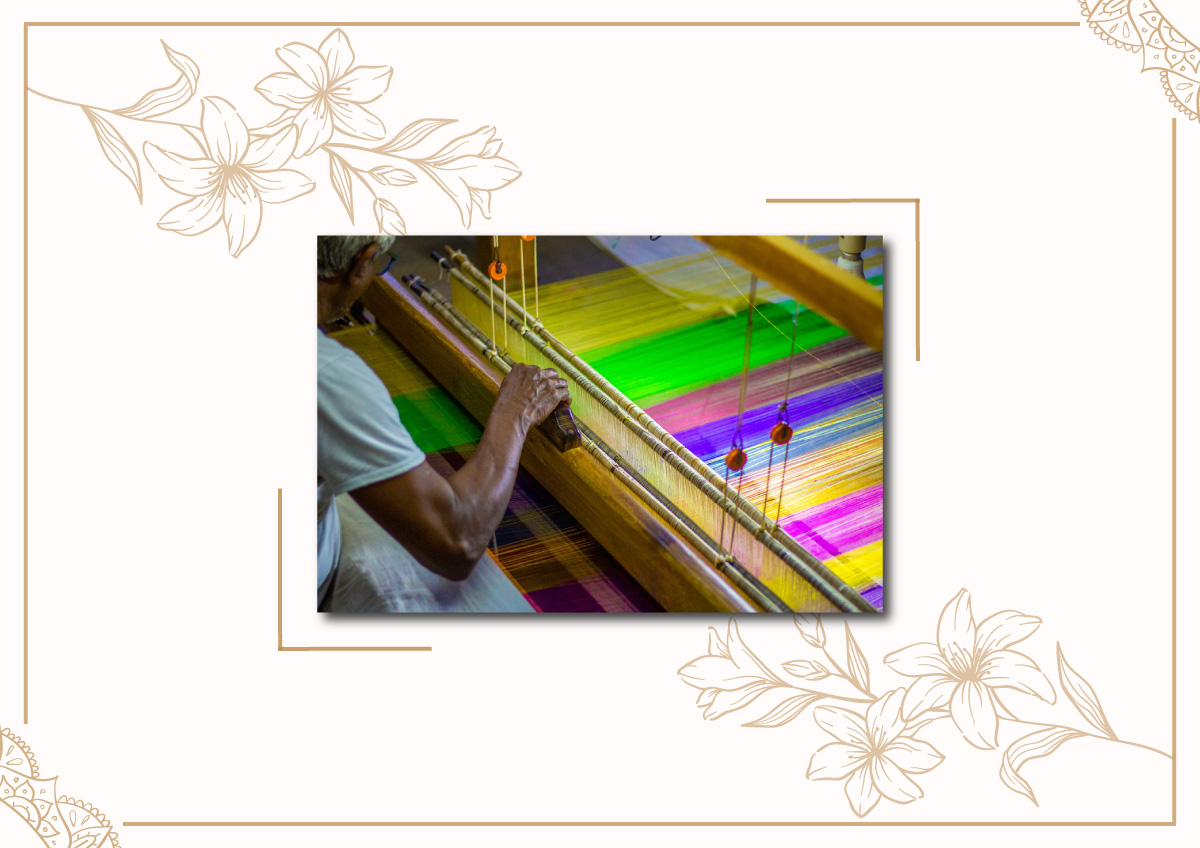Silk Saree Making and Weaving Process - How is Silk Made into Fabric?
History of Silk Fabric
China is the birthplace of silk and it was discovered in the first millennium BC. For thousands of years, the Chinese confined the production of silk textiles. Later in the Second century, trade routes from China were opened to export silk exclusively to Euro-Asian countries like India and France.
In India, silk cultivation began with the Indus Valley civilization. Silk is called different in India. In North and Eastern India, it is called Resham, and in the South, it is called Pattu. India is the second largest silk producer in the world after China. In India, raw mulberry silk is produced from six states namely, Andhra Pradesh, Karnataka, Jammu and Kashmir, Tamil Nadu, Bihar, and West Bengal.
Kancheepuram silk sarees and Pochampalli silk sarees are world-renowned silk sarees that originate from Tamil Nadu and Andhra Pradesh respectively. These silk sarees are characterised by intricate designs, vibrant colours, and delicate textures.
Learn about some different types of the latest saree fabrics for a stylish look.
Silk Sarees Making Process
Kanchipuram and Salem are popular districts in Tamil Nadu that are the largest manufacturers of silk sarees. A community of people are engaged with artisans carrying the legacy of making silk sarees for generations. Silk sarees are renowned for their intricate work and Zari design. There are several involved in making a silk saree. Let’s take a detailed look at each step.
Buy traditional silk sarees from Tulsi Silks. For any of your celebrations, Tulsi Silks offers an exclusive collection of Banarasi silk sarees to Mysore silk sarees for an elegant look.
Let’s dive into the process of silk saree-making!
Collecting
Caterpillars form a protective layer around the pupa, spinning silk fibres known as cocoons, during the larvae-to-pupa transition. These cocoons are collected by weavers or cooperative societies. Sometimes weavers leave the larvae to spin a large cocoon. The larvae are removed with hot air or steam to remove the silky thread. Each cocoon has 600 to 900 meters of silk strands.
Reeling
Silk reeling is the process of unwinding the delicate silk threads from cocoons to create the raw material for weaving silk sarees and other fabrics. Softened cocoons are gently brushed to find the loose end of the silk thread. This loose end is attached to a spinning mechanism. As the cocoon is rotated, the silk thread starts to unwind. Multiple cocoons can be unwound simultaneously to create a thicker thread.
Dyeing
Silk threads can be dyed before weaving to obtain the desired colours. Consequently, silk is very versatile and can be used to create several textiles that are colourful and varied.
Check out our blog on silk saree colour combinations to find out some of the ever-green combinations that will make people look twice!
Warping
Warping silk is an essential step in the preparation of silk threads for weaving. It involves arranging a set of parallel threads, known as the warp, onto a frame or loom. Warp beams are large cylindrical spools onto which the silk threads will be wound. The threads are aligned with the help of a warping machine or board. This process ensures that the threads are properly positioned and ready for weaving a saree.
Setting the loom
Setting up a loom for weaving a silk saree is a meticulous process. It involves arranging the warp and weft threads in a specific way to create the desired fabric. Warp threads, which were previously wound onto the warp beam, are now attached to the loom's frame. Following the design and pattern requirements, the threads are threaded through the heddles and then through the reed.
To purchase silk sarees, check the best silk saree shops in Chennai to buy authentic and traditional silk sarees.
Winding Weft
Winding the weft is a crucial step in weaving a silk saree, where the weft threads are carefully prepared and inserted horizontally across the warp threads on a shuttle or bobbin. The weft material can vary, including silk, cotton, wool, or synthetic fibres, depending on the texture, colour, and strength of the final fabric. Weft thread length is determined by the width of the fabric woven.
Making a Saree
After the completion of weaving silk sarees, the fabric is carefully removed from the loom. It undergoes any necessary finishing process, such as washing, ironing, and adding decorative elements like borders and embellishments. The woven saree is carefully examined for defects or imperfections. Once the quality check is complete, the saree is folded and neatly packaged to reach the stores.
Explore our exquisite collection of silk sarees, meticulously handcrafted by Tulsi Silks artisans.
Types of Silk Sarees
Silk sarees in India are known for their distinctive weaving techniques, designs, and cultural significance. The following are some types of silk sarees:
Kanjeevaram Silk Sarees
Kanjivaram sarees are centuries-old and known for their grandeur-rich borders from Tamil Nadu. Inspired by Tamil Nadu's rich heritage, Kanjivaram sarees have motifs that depict Hindu gods, nature, and daily life.
Maintain your valuable silk sarees with our tips on how to care for a silk saree.
Banarasi Silk Sarees
Banarasi sarees are traditional sarees from the city of Varanasi. Known for their intricate designs, fine silk fabrics, and luxurious embellishments
Mysore Silk Sarees
Intricate designs and vibrant colours make Mysore silk sarees stand out. They are a popular choice for traditional and formal occasions.
Tussar Silk Sarees
Tussar silk sarees feature a diverse range of vibrant designs, patterns, and prints. Tussar silk sarees incorporate tribal art forms like warli paintings evoking a rustic and ethnic charm.
Chaniya Silk Sarees
Chaniya silk sarees are like Katan silk and are made from a type of silk called Chiniya. These sarees are adorned with intricate embroidery, mirror work and decorative elements
Uppada Silk Sarees
Uppada Silk Sarees are handwoven luxurious silk sarees with intricate weaving techniques, rich colours, and elegant designs.
Silk Cotton Sarees
Silk Cotton Sarees are made by weaving silk and cotton threads together. The presence of cotton fibres makes Silk Cotton Sarees more breathable and comfortable.
Raw Silk Sarees
Raw Silk Sarees are made from natural silk fibres that have not undergone extensive processing. These sarees have a distinct texture and appearance.
Check out our other blog, our exclusive guide on how to perfectly drape a silk saree for a wedding.
We hope this blog has thrown light on the hard work and dedication of artisans in weaving stunning silk sarees. The entire process of weaving a silk saree justifies why they are really expensive. When you purchase a silk saree next time, remember to appreciate and thank the weavers for creating a magnificent piece.
Tulsi Silks is Chennai’s most trusted and authentic store for buying silk sarees for weddings and other occasions. Tulsi Silks offers a wide selection of traditional and contemporary silk sarees, with a variety of designs, colours, and textures. Shopping at Tulsi Silks is a delightful experience and we invite you to come and experience the beauty of silk sarees.




